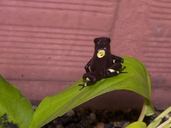|
Oophaga histrionica (Berthold, 1845)
Harlequin Poison Frog | family: Dendrobatidae subfamily: Dendrobatinae genus: Oophaga |
| Species Description: Berthold, A. A. 1845. Ueber verschiedene neue oder seltene Reptilien aus Neu-Granada und Crustaceen aus China. Nachrichten von der Georg-Augusts-Universität und der Königl. Gesellschaft der Wissenschaften zu Göttingen 1845: 37–48. | |
|
Etymology: In 2011, the genus Dendrobates was subdivided into seven genera, including the new genus Oophaga by Brown et al. (2011). The origin of the genus name, "Oophaga", comes from the Greek words, "oon" and "phagein", meaning "egg" and "eat", respectively (Ortiz et al. 2018). |
|
 © 2008 Esteban Alzate (1 of 36) |
|
|
|
Description Distribution and Habitat Country distribution from AmphibiaWeb's database: Colombia, Ecuador
Life History, Abundance, Activity, and Special Behaviors Comments
References
Brown J.L., Twomey E., Amézquita A., De Souza M.B., Caldwell J.P., Lötters S., Von May R., Melo-Sampaio P.R., Mejía-Vargas D., Perez-Peña P., Pepper M., Poelman E.H., Sanchez-Rodriguez M., and Summers K. (2011). "A taxonomic revision of the Neotropical poison frog genus Ranitomeya (Amphibia: Dendrobatidae)." Zootaxa, 3083, 1-120. [link] Duellman, W. E., and Trueb, L. (1986). Biology of Amphibians. McGraw-Hill, New York. Walls, J. G. (1994). Jewels of the Rainforest: Poison Frogs of the Family Dendrobatidae. J.F.H. Publications, Neptune City, New Jersey. Originally submitted by: Franziska Sandmeier (first posted 2001-03-21) Edited by: Kellie Whittaker, Brent Nguyen (2024-08-22) Species Account Citation: AmphibiaWeb 2024 Oophaga histrionica: Harlequin Poison Frog <https://amphibiaweb.org/species/1633> University of California, Berkeley, CA, USA. Accessed Jun 8, 2025.
Feedback or comments about this page.
Citation: AmphibiaWeb. 2025. <https://amphibiaweb.org> University of California, Berkeley, CA, USA. Accessed 8 Jun 2025. AmphibiaWeb's policy on data use. |



 Map of Life
Map of Life